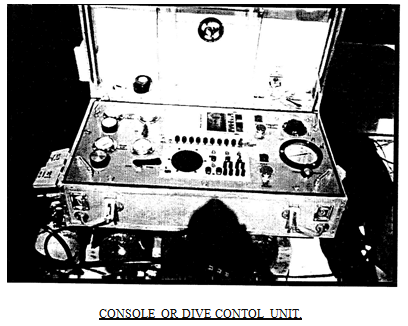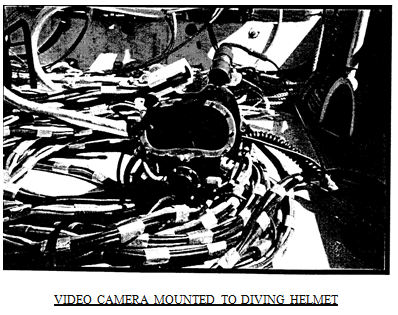 Underwater Inspection and Evaluation
Underwater Inspection and Evaluation
“A Critical Component” for Preventative Maintenance, Operation and Relicensing
William J. Castle, P.E.
W.J. Castle, P.E. & Associates,
P.C. 693 Main Street, Building B, Suite 1
Lumberton, New Jersey 08048 USA
Abstract
All dams, from small earthen structures to large hydro facilities, have critical areas or components which are not visible or easily inspected. These critical areas are located underwater and therefore not always considered until a problem occurs. In addition, qualified underwater inspectors are not always specified which contributes to this problem. The benefits of specifying regular underwater inspections with professional underwater diver/engineers will be emphasized and discussed in detail. Also, types of dams with critical areas to be inspected and recommended equipment will be highlighted.
Introduction
All organizations realize that periodic inspections of dams are necessary and required for maintenance and “upkeep” of the structures. However, one area of inspection that is extremely important but often not emphasized or performed is “Underwater”. The degree of inspection and qualification of the inspection are usually very well defined for portions above water, but, underwater inspections and qualifications of the diver/inspector are usually not as defined or rigid.
The frequency of inspection will be dependent upon the expected rate of deterioration and damage. A typical example requiring more frequent inspection in an area experiencing damage by the results in advanced deterioration. The frequency and level of inspection should, therefore, be closely tied to the historical deterioration rate of the facility.
All underwater structural members should be inspected at least every 6 years, starting at the splash/tidal zones and working down. As deterioration is discovered, the level of inspection and frequency needs to be increased accordingly.
The importance of using trained qualified commercial divers with technical or engineering background cannot be emphasized enough. “What you cannot see will create problems” and an inspection by unqualified personnel can generate information that is not correct or inconclusive. Understanding the problem and what may have caused it is just are critical for “Underwater Inspections” as it is for other types of inspections.
GENERAL PURPOSE AND INTENT OF UNDERWATER INSPECTION
Preventive Maintenance involves the replacement of component parts on a regular basis, often before signs of deterioration are evident. This practice minimizes the incidence of costly and possibly dangerous situations that may arise from unexpected deterioration or failure of a component.
A. Types of Maintenance
- Minor maintenance – General repairs carried out on a regular basis to maintain good operating condition.
- Major maintenance – Includes all other repairs or remedial work and generally requires design and technical input.
All maintenance is dependant upon all or part of the following areas:
1. Technical evaluation of underwater inspection observations
2. Proper identification of the cause of damage or deterioration.
3. Preparation of repair methods and costs
4. Selection of optimum solution (Innovative)
QUALIFICATIONS & EQUIPMENT
A. Personnel Qualifications
The success of any inspection program depends on the training and dedications of those persons charged with the actual inspection, whether for an underwater or an above-water inspection. An appreciation of the importance of the work to the safety of lives and property and dedication to doing a good job are essential prerequisites. Attitude and realization of the importance of a proper inspection and responsibility to ensure the overall dam safety is important. Good intentions alone, however, are not sufficient qualifications for the underwater inspector. He must be trained both as a diver and an inspector. Training in only one of these areas will not suffice. Comprehensive training of underwater inspectors is even more important than training of above-water inspectors since the underwater inspector is often the only person who can or will see a structure underwater. He must have the ability to recognize the structural significance of conditions he encounters underwater; the judgment to expend his inspection effort to commensurate with the indicators of defects he perceives, and the technical competence and vocabulary to relate his findings to someone on the surface.
The underwater inspector should also be an experienced and accomplished commercial diver. Especially since the diving conditions are usually adverse and dangerous and can include penetration diving and decompression.
The competence and experience required by the inspector-diver depend on the dam structure and all areas to be inspected. All underwater inspections should be conducted under the direct supervision of a fully qualified structural inspection team leader/engineer. Some dams are of such complexity that they require the actual diving inspection to be conducted by a fully qualified team leader/engineer. In fact, in some cases, only a professional engineer experienced in underwater inspections would be considered qualified. In other cases, a diver fully trained and experienced in the inspection and evaluation of dam structure would meet the inspection and safety requirements.
In addition to technical qualifications, the underwater inspector is subjected to hyperbaric conditions and must be in good physical and psychological condition. Divers in the USA are required to have an annual medical examination to comply with Occupational Safety and Health Administration (OSHA) Standards, and a copy of the examination findings must be kept on file by the divers’ employer. Refer to the OSHA regulations in the Appendix for details of the medical examination requirements. Because of the polluted waters in which some inspections must be made, all divers’ immunizations should be current.
B. Training/Qualifications
At present, there is no single, nationally or internationally recognized dive certification agency that specifies any minimum technical requirements for a diver to be certified as an Underwater Inspector. Three types of formal diving training are commonly available: certification from a recognized diver training program, (e.g; YMCA; PADI, i.e.; Professional Association of Diving Instructors; and NAUI, i.e.; the National Association of Underwater Instructors), certification from a commercial diving school, and military training. In addition, organizations specializing in marine studies, such as NOAA, the National Oceanographic and Aeronautical Administration, offer diving training. Many divers also receive initial or advanced training on the job. In fact, most training for inspections is actually acquired by experience while performing the actual inspection.
Programs conducted by organizations such as the YMCA, PADI, and NAUI are oriented toward the recreational diver. A recreational diver having advanced through a number of certification levels or having dived for a number of years can gain, but may not necessarily have gained, the diving competence necessary to cope with the conditions commonly encountered during dam inspection.
Graduates of commercial diving schools are generally better prepared initially for the diving conditions encountered in underwater inspections. They are taught various types of diving methods, equipment maintenance, and how to perform mechanical tasks underwater. Some schools also provide specialty courses in Nondestructive Testing (NDT). When students graduate from a commercial diving school, they often join a diving company as a tender or tender-diver gaining experience before they are considered fully qualified commercial divers.
 Military divers complete extensive courses in various types of diving systems, and normally receive extensive on-the-job training and experience in diving operations, but usually not the same extensive training as a commercial diver.
Military divers complete extensive courses in various types of diving systems, and normally receive extensive on-the-job training and experience in diving operations, but usually not the same extensive training as a commercial diver.
However, none of the training alternatives described above fully prepares a diver for the conditions typically encountered during underwater inspections, either from a diving or a technical perspective. A novice inspector-diver, regardless of type of dive training he has received, should receive additional on-the-job training under the supervision of an experienced inspector-diver. Additional training can include familiarization with diving under actual site conditions, recognition of structural distress, underwater photography and video, and NDT.
Diver training, like inspection training, should be supplemented periodically by refresher training. Divers can only maintain their competency through continued practice. Divers who have not had regular and recent in-water experience can pose a threat to themselves and others if placed in a hazardous situation without sufficient time to acclimate themselves.
Occupational Safety and Health Administration (OSHA) (USA Requirements) Some of the key provisions are as follows:
Personnel Requirements:
- All divers must be trained in their duties, including dive physiology, first aid and cardiopulmonary resuscitation (CPR).
General and Specific Operating Procedures:
- All employers must develop a Safe Diving Practices Manual for their diving operations.
- An employer designated person-in-charge of the operation, who is qualified by training and experience, must conduct pre-dive and post-dive briefings.
- The use of surface-supplied air is not allowed at depths greater than 220 feet sea water (fsw).
- For dives to depths deeper than 100 feet sea water (fsw) or for dives outside the no-decompression limits, a decompression chamber must be on-site ready for use.
Equipment Procedures:
- The standard specifies minimum equipment requirement for the diver and diving operations; and equipment testing and maintenance requirements.
C. Inspection Team
Management
The management of diving personnel, whether by a governmental agency, a contractor or a consultant, poses special problems because of the hazardous nature of the work.
Diving work is very strenuous. As a result, divers generally cannot spend an entire day working underwater. A great amount of time and energy is often expended in preparation for a dive of short duration. It must be remembered that this is not lost time, but rather part of the total work effort.
Team Requirements
The diving team should consist of a minimum of three (3) persons and if penetration diving is required there should be at least four (4) persons. The following is a “recommended diving team” to be used for basic underwater inspections.
- Engineer Team Leader/Diver
- Commercial Diver Tender
- Tender/Commercial Diver
The Engineer and Diver performing the inspection should have a minimum of five (5) years of experience in inspecting dams of similar types as the Project.
Special Requirements
In soliciting underwater inspection services, special situations sometimes arise which can significantly affect the effort, support equipment, and cost of the inspection. Some of these are difficult to foresee. Several more common considerations are addressed in the following paragraphs. The contract administrator should be alert to these conditions an provide any available information concerning special requirements in the request for proposal.
Penetration & Special Dives
When divers are used to inspecting pipes, draft tubes, penstocks, etc. with minimal available headroom where contaminated air may be present and access is limited safety must be considered first and foremost.
Also, during an inspection of hydro-electric facilities, all turbine power, etc. must be shut-down, locked and tagged.
Because a diver in distress cannot usually ascend to the surface in penetration dives, additional precautions and a larger dive team are usually needed. In addition to surface dive tenders, a diver-tender must be stationed at the point of entry to a confined space such as a submerged pipe. The dive team should consist of a minimum of four (4) persons.
While many waters are becoming cleaner, there is increased awareness of potential harmful effects of waters polluted with a variety of chemicals and wastes, even in very small amounts. Any available information on water quality should be supplied with a request for proposals. Some states are now classifying water quality as part of their record keeping process, and this is recommended for all agencies.
D. Record Keeping
Records of all dives and all diving accidents must be maintained. In general, the OSHA standards provide a good basis for ensuring safe diving operations during an underwater inspection, but compliance with the standards, in themselves, may not be sufficient. A company or agency diving safety program, coupled with competent, experienced divers and dive managers, is essential to preventing serious diving accidents. Many commercial organizations and governmental agencies have developed comprehensive policies to govern their specific diving operations. A standard “Operation Manual” should be requested of the diving Company performing Underwater Inspection.
This is part 1 of a 4-part series.
You can find part 2 here.
Read part 3 here.
Read the 4th of this 4-part series here.